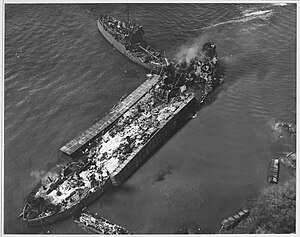USS LST-480 was an LST-1-class tank landing ship built for the United States Navy used in the Asiatic-Pacific Theater during World War II.
 Overhead view of the burning hulk of USS LST-480, in the West Loch, Pearl Harbor, 22 May 1944. The yard craft with her bow on the bow of LST-480 appears to be an LCM, while the ship at her stern is USCGC Woodbine.
| |
| History | |
|---|---|
| Name | LST-480 |
| Ordered | as a Type S3-M-K2 hull, MCE hull 1000[1] |
| Builder | Permanente Metals Corporation, Richmond, California |
| Yard number | 35[1] |
| Laid down | 31 August 1942 |
| Launched | 29 October 1942 |
| Commissioned | 3 May 1943 |
| Out of service | 21 May 1944 |
| Stricken |
|
| Identification |
|
| Honors and awards | |
| Fate | Sunk by accidental explosion of ammunition 21 May 1944 |
| General characteristics [2] | |
| Class and type | LST-1-class tank landing ship |
| Displacement |
|
| Length | 328 ft (100 m) oa |
| Beam | 50 ft (15 m) |
| Draft |
|
| Installed power |
|
| Propulsion |
|
| Speed | 12 kn (22 km/h; 14 mph) |
| Range | 24,000 nmi (44,000 km; 28,000 mi) at 9 kn (17 km/h; 10 mph) while displacing 3,960 long tons (4,024 t) |
| Boats & landing craft carried | 2 or 6 x LCVPs |
| Capacity |
|
| Troops | 16 officers, 147 enlisted men |
| Complement | 13 officers, 104 enlisted men |
| Armament |
|
| Service record | |
| Operations: |
|
| Awards: | |
Construction
editLST-480 was laid down on 31 August 1942, under Maritime Commission (MARCOM) contract, MC hull 1000, by Kaiser Shipyards, Yard No. 4, Richmond, California; launched on 29 October 1942; and commissioned on 3 May 1943.[1][3][2]
World War II Pacific Theatre operations
editDuring World War II, LST-480 was assigned to the Asiatic-Pacific theater and participated in the following operations:
- Gilbert Islands operation: Capture and occupation of Gilbert Islands, 13 November to 8 December 1943.
- Marshall Islands operation: Occupation of Kwajalein and Majuro Atolls, 29 January to 8 February 1944.
Sinking
editOn 21 May 1944, LST-480 and at least 28 to 33 other LSTs were gathered near Waipio peninsula, in Pearl Harbor's West Loch, loading ammunition and supplies in preparation for the invasion of Saipan.[4][5]
At 15:08, an explosion onboard LST-353, which may have originated near LCT-963, caused a chain reaction that would eventually sink LST-480, LST-353, and four other LSTs. At least two other LSTs were severely damaged and 163 sailors were killed with another 396 wounded.[4][5]
While the other ships were removed and sunk at sea,[5] the wreck of LST-480 can still be seen in the West Loch.[6] 21°21′26″N 157°59′50″W / 21.35725°N 157.9972°W
Awards
editLST-480 earned two battle stars for World War II service.[3]
Notes
edit- Citations
Bibliography
editOnline resources
- "LST-480". Dictionary of American Naval Fighting Ships. Naval History and Heritage Command. Retrieved 2 February 2017. This article incorporates text from this source, which is in the public domain.
- "Kaiser Permanente No. 4, Richmond CA". ShipbuildingHistory.com. 5 February 2014. Retrieved 2 February 2017.
- "USS LST-480". Navsource.org. 20 May 2016. Retrieved 2 February 2017.
- "West Loch Disaster". United States Navy. Retrieved 2 February 2017.
- "West Loch Disaster". National Park Service. 27 April 2001. Retrieved 2 February 2017.
- "Memorial Day, 2009". The Boston Globe. 25 May 2009. Retrieved 2 February 2017.
Further reading
edit- Olson, Wyatt (21 May 2016). "'2nd Pearl Harbor,' kept top secret until 1962, commemorated". Stars and Stripes. Retrieved 2 February 2017.
- Shute, Megan (20 January 2017). "The Deadly History of This Hawaii Harbor Is Terrifying But True". Only in Your State. Retrieved 2 February 2017.
External links
edit- Photo gallery of USS LST-480 at NavSource Naval History